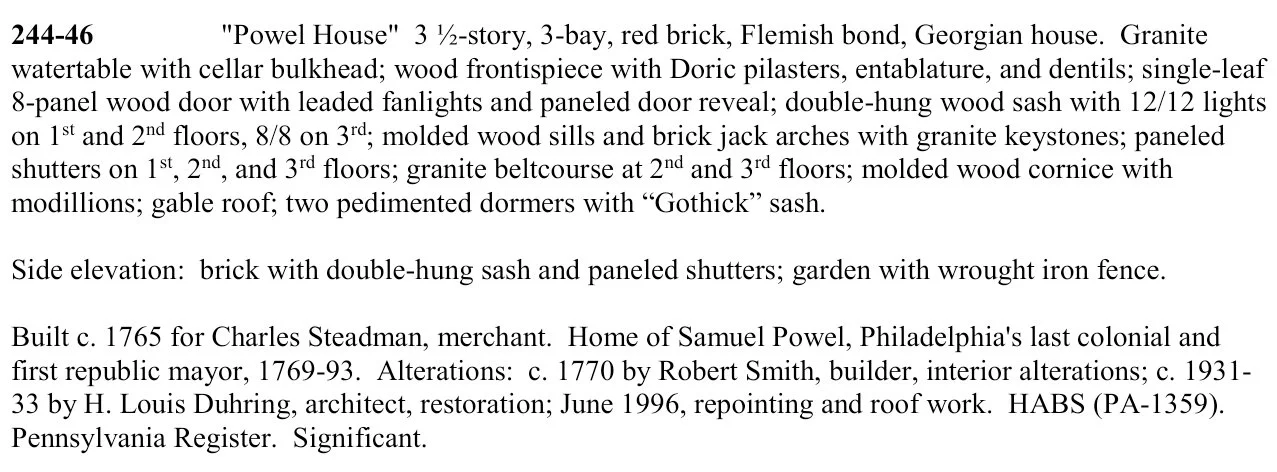Historic Quaker Houses of Philadelphia
Birthright Quakers who became Anglican:
The Powel House
244 South Third Street
Built in 1765
Image source: Lee J. Stoltzfus
The Powel House
One of the Finest Georgian Townhouses in Philadelphia:
Above: The Powel House’s largest and most opulent room is the second-floor parlor / ballroom. George and Martha Washington were featured guests at a ball in this room when the Powels celebrated the Washingtons’ twentieth wedding anniversary here in the house. George Washington danced here. Image source: Lee J. Stoltzfus
Above left: Samuel Powel III portrait by Angelica Kauffman. Image source: PhilaLandmarks.org
Above right. Elizabeth Willing Powel portrait by Matthew Pratt. Image source: PhilaLandmarks.org
Above: In this 1765 portrait Powel holds an architectural plan for an anonymous building. His father and grandfather were both named Samuel Powel, and were both wealthy builders and real estate investors. Samuel Powel III of the Powel House inherited 90 houses and other properties from his grandfather.
Above: Second-floor parlor in the Powel House, with portrait of Elizabeth Powel. Image source: Lee J. Stoltzfus
Ornate Interiors by Master Builder Robert Smith
Samuel Powell III commissioned Philadelphia’s best carpenter-bulder, Robert Smith, to create the magnificent panelled-and-carved interiors for his house. Smith hired four of the city’s leading architectural carvers to embellish the interior woodwork: Hercules Courtenay, Bernard and Martin Jugiez, and James Reynolds.
The Rococco-style carving represents some of the finest examples of 18th-century architectural woodwork in Philadelphia.
Powel House Description
Philadelphia Register of Historic Places:
Image source: Philadelphia Register of Historic Places
Samuel Powel Inherited Wealth from this Quaker Grandfather
Who Donated the Land for the Pine Street Quaker Meetinghouse:
Above: Pine Street Quaker Meetinghouse. Image source: TriCollege Libraries
Above: Samuel Powel’s grandfather, Samuel Powel, Sr., donated the land for this Quaker meetinghouse on Pine Street, near the market at today’s Head House Square. By the year of this map, 1862, meetings were discontinued here, but the school house remained. Image source: Atlas of the City of Philadelphia (1862), FreeLibrary.org
Samuel Powel III, owner of the Powel House, inherited much of his wealth from his Quaker grandfather, Samuel Powel, Sr. (1673 - 1756). This Powel grandfather had donated the land for the Quaker meetinghouse on Pine Street (above), which was built in 1753. Meetings discontinued there in 1832.
This Samuel Powel, the grandfather, was born in England to Welsh parents. He became a wealthy builder / developer in Philadelphia, where he eventually owned 90 properties. “He was known as the “rich carpenter.”
Samuel Powel III, of the Powel House, inherited his grandfather’s 90 properties, along with the wealth his Quaker father had accumulated as a merchant. He became one of the wealthiest men in the American colonies.
The 1710 Philadelphia Courthouse
Built by Samuel Powel, Sr.:
Image source: The Atheneum, text added.
Above: The 1710 Courthouse was constructed by master builder Samuel Powel, Sr., the grandfather of Samuel Powel III who owned the Powel House. Across High Street the Quaker meetinghouse claimed its central position of authority in the city.
Samuel Powel of the Powel House inherited his wealth from his Powel grandfather and father, both of whom were builders / carpenters / real estate investors. The Powel family’s generational wealth allowed Samuel Powel III to build one of the finest Georgian houses in Philadelphia: the Powel House.
His Quaker grandfather and father were no longer living when Powel built the lavish interiors for his Powel House. Had those Powel patriarchs seen this exceptional house, they hopefully would have appreciated the masterful craftsmanship of the Powel House’s lavish interior. Even if the house’s ornate opulence might have been too prideful for their own Quaker sensibilities.
Samuel Powel’s Powel House sometimes feels like an architectural tribute to the ancestral Quaker Powels who helped build Philadelphia.
U. S. Presidents Visit the Powels at the Powel House:
Samuel and Elizabeth Powel were one of the most prominent couples in Philadelphia. Samuel Powel was twice mayor of the city and was a Pennsylvania state senator. Elizabeth Powel was daughter of a Philadelphia mayor and was an important political advisor.
The Powel House was a hub of social life and political discourse. It was a Philadelphia cultural salon. High-profile visitors included George and Martha Washington, John and Abigail Adams, Benjamin Franklin, and the Marquis de Lafayette.
Samuel Powel and the Powel House
Trying to Stay Neutral during the Revolutionary War:
Samuel Powell III was a birthright Quaker. He was born into the Society of Friends by virtue of his parents’ membership. His wife, Elizabeth Willing, was from an Anglican family. In 1769 the couple got married in Philadelphia’s Anglican St. Peter’s Church. By marrying “out of meeting” Powel broke official ties to his Quaker membership.
During the Revolution the Samuel Powel tried to stay neutral, as neither loyalist nor patriot. Neutrality was a typical Quaker goal during those troubled times. In Powel’s case, neutrality was a Quaker-Anglican goal.
Some Revolutionary leaders were concerned that the Powels should be more loyal to the patriots. So in 1780 Powel publicly donated 5,000 pounds to the Continental Army to demonstrate his support for their cause. His pacifist Quaker relatives who were committed to nonviolence undoubtedly disapproved of that concession to warfare.
After the war Samuel Powel was the first mayor of an independent Philadelphia. Today, Samuel and Elizabeth Powel are interred in the Episcopal burial ground at Christ Church.











